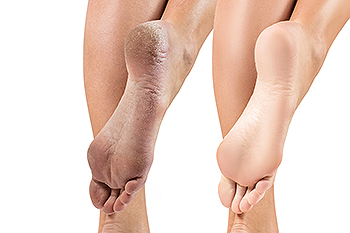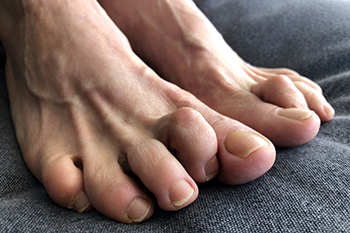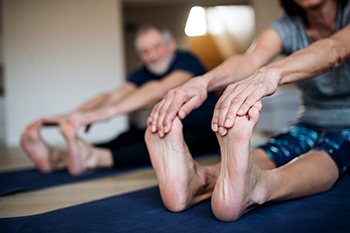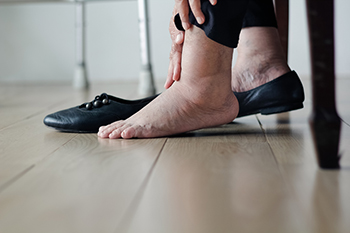
Drexel Hill (484) 521-0233
West Chester (610) 436-5883

Drexel Hill (484) 521-0233
West Chester (610) 436-5883

Cracked heels are not merely a cosmetic concern, their impact can extend beyond the surface, and may affect overall foot health and well-being. These painful fissures in the skin create an entry point for bacteria, increasing the risk of infections. As the cracks deepen, they can lead to bleeding and expose sensitive tissues, causing discomfort and hindering mobility. In severe cases, untreated cracked heels may contribute to balance issues, potentially increasing the risk of falls, particularly in older individuals. The pain associated with cracked heels can alter gait patterns, placing undue stress on other joints, such as the knees and hips. Moreover, the constant pressure on the feet can lead to chronic inflammation, exacerbating conditions such as plantar fasciitis. Addressing cracked heels involves more than cosmetic care, it is a vital aspect of maintaining overall foot health and preventing potential complications that can impact one's daily life and mobility. If you have cracked heels, it is suggested that you schedule an appointment with a podiatrist who can offer prescribed medication as an effective treatment method.
Cracked heels are unsightly and can cause further damage to your shoes and feet. If you have any concerns, contact the podiatrists from Dr. Siegerman & Associates. Our doctors can provide the care you need to keep you pain-free and on your feet.
Cracked Heels
Cracked heels appear unappealing and can make it harder for you walk around in sandals. Aside from looking unpleasant, cracked heels can also tear stockings, socks, and wear out your shoes. There are several methods to help restore a cracked heel and prevent further damage.
How Do You Get Them?
Dry skin is the number one culprit in creating cracked heels. Many athletes, walkers, joggers, and even swimmers suffer from cracked heels. Age and skin oil production play a role to getting cracked heels as well.
Promote Healing
Over the counter medicines can help, especially for those that need instant relief or who suffer from chronic dry feet.
Wear Socks – Wearing socks with medicated creams helps lock in moisture.
Moisturizers – Applying both day and night will help alleviate dryness which causes cracking.
Pumice Stones – These exfoliate and remove dead skin, which allows for smoother moisturizer application and better absorption into the skin.
Change in Diet
Eating healthy with a well-balanced diet will give the skin a fresh and radiant look. Your body responds to the kinds of food you ingest. Omega-3 fatty acids and zinc supplements can also revitalize skin tissue.
Most importantly, seek professional help if unsure how to proceed in treating cracked heels. A podiatrist will help you with any questions or information needed.
If you have any questions, please feel free to contact one of our offices located in Drexel Hill and West Chester, PA . We offer the newest diagnostic and treatment technologies for all your foot care needs.

Hammertoe is a condition where one or more toes exhibit an abnormal bending at the middle joint. In most cases of hammertoe, the second toe is affected. This prevalent foot deformity can lead to discomfort and biomechanical complications. The causes of hammertoe are diverse. Included are an unusually long metatarsal or toe bone, poor alignment of foot joint surfaces, and prolonged wear of ill-fitting shoes. The constriction imposed by tight or narrow shoes often aggravates the condition and potentially causes calluses, corns, ulcers, and metatarsal pain. Treatment for hammertoe by a podiatrist aims at alleviating pain and preventing complications, with a focus on wearing appropriate footwear that features a wide toe box to reduce pressure. Additionally, toe pads and orthotics may be recommended to shield the toes from any shoe related discomfort. Prompt treatment of skin irritations and ulcers is essential. Surgical intervention becomes an option when other measures fail to relieve pain and disability. Its aim is to straighten the rigidly fixed toe deformity and correct its alignment. If you suspect a hammertoe or experience foot pain, it is suggested that you make an appointment with a podiatrist for an examination and treatment options.
Hammertoe
Hammertoes can be a painful condition to live with. For more information, contact the podiatrists from Dr. Siegerman & Associates. Our doctors will answer any of your foot- and ankle-related questions.
Hammertoe is a foot deformity that affects the joints of the second, third, fourth, or fifth toes of your feet. It is a painful foot condition in which these toes curl and arch up, which can often lead to pain when wearing footwear.
Symptoms
Causes
Genetics – People who are genetically predisposed to hammertoe are often more susceptible
Arthritis – Because arthritis affects the joints in your toes, further deformities stemming from arthritis can occur
Trauma – Direct trauma to the toes could potentially lead to hammertoe
Ill-fitting shoes – Undue pressure on the front of the toes from ill-fitting shoes can potentially lead to the development of hammertoe
Treatment
Orthotics – Custom made inserts can be used to help relieve pressure placed on the toes and therefore relieve some of the pain associated with it
Medications – Oral medications such as anti-inflammatories or NSAIDs could be used to treat the pain and inflammation hammertoes causes. Injections of corticosteroids are also sometimes used
Surgery – In more severe cases where the hammertoes have become more rigid, foot surgery is a potential option
If you have any questions please contact one of our offices located in Drexel Hill and West Chester, PA . We offer the newest diagnostic and treatment technologies for all your foot and ankle needs.

Exercising the feet and ankles regularly can ward off pain and strengthen these areas, enhancing flexibility in the process. Simple routines like stretching the big toe, spreading the toes, extending the Achilles tendon, and walking in sand can be especially helpful. These exercises ensure that the foot muscles are strong and supportive, contributing to an increased range of motion which is vital for long-term activity and mobility. These types of exercises are straightforward and can be easily integrated into daily routines without the need for specialized equipment. Whether at home or as part of a gym workout, they can become a regular aspect of anyone's fitness regimen, aiding in the maintenance of foot health and overall well-being. If you are interested in learning more about stretching the feet and specific exercises you can do, it is suggested that you make an appointment with a podiatrist who can provide the information you are seeking.
Why Stretching Is Important for Your Feet
Stretching the feet is a great way to prevent injuries. If you have any concerns with your feet consult with the podiatrists from Dr. Siegerman & Associates. Our doctors will assess your condition and provide you with quality foot and ankle treatment.
Stretching the Feet
Stretching the muscles in the foot is an important part in any physical activity. Feet that are tight can lead to less flexibility and make you more prone to injury. One of the most common forms of foot pain, plantar fasciitis, can be stretched out to help ease the pain. Stretching can not only ease pain from plantar fasciitis but also prevent it as well. However, it is important to see a podiatrist first to determine if stretching is right for you. Podiatrists can also recommend other ways to stretch your feet. Once you know whether stretching is right for you, here are some excellent stretches you can do.
It is best to go easy when first stretching your foot and work your way up. If your foot starts hurting, stop exercising to ice and rest the foot. It is advised that you then see a podiatrist for help.
If you have any questions, please feel free to contact one of our offices located in Drexel Hill and West Chester, PA . We offer the newest diagnostic and treatment technologies for all your foot care needs.

Swollen feet can arise due to various health concerns, including skin infections and underlying health conditions. For instance, cellulitis is a painful bacterial infection causing swelling, redness, and warmth in the affected region. Particularly vulnerable are individuals with diabetes. They often face complications due to reduced healing ability and decreased sensation, which can lead to unnoticed injuries becoming infected and subsequently causing foot swelling. Another condition, lymphedema, results from impaired lymph flow, often due to damaged or removed lymph nodes. It can be congenital or caused by factors such as cancer treatments or infections. Heart failure, a severe medical condition, results in fluid accumulation, with swollen feet as a common symptom. Prolonged immobility can cause deep vein thrombosis, a potentially life-threatening blood clot. Kidney issues can also lead to swollen feet if fluid balance is disturbed. Additionally, liver disease, especially cirrhosis, can cause fluid accumulation in the lower extremities due to portal hypertension. If you have swollen feet that do not respond to rest, it is suggested that you make an appointment with a podiatrist to identify the root cause of the swelling and get treatment appropriate to what is discovered.
Swollen feet can be a sign of an underlying condition. If you have any concerns, contact the podiatrists of Dr. Siegerman & Associates. Our doctors can provide the care you need to keep you pain-free and on your feet.
Swollen feet are a common ailment among pregnant women and people who stand or sit for extended periods. Aging may increase the possibility of swollen feet and patients who are obese often notice when their feet are swelling too. There may be medical reasons why swollen feet occur:
Swollen feet can also be caused by bone and tendon conditions, including fractures, arthritis, and tendinitis. Additionally, there may be skin and toenail conditions and an infection may cause the feet to swell. Patients who take medicine to treat high blood pressure may be prone to getting swollen feet.
Many patients elevate their feet to help relieve the swelling and this is generally a temporary remedy. When a podiatrist is consulted the reason behind the swelling can be uncovered and subsequently treated.
If you have any questions please feel free to contact one of our offices located in Drexel Hill and West Chester, PA . We offer the newest diagnostic tools and technology to treat your foot and ankle needs.
Request a free copy of
Laser Away Foot Pain!
today.
